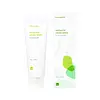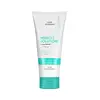What's inside
What's inside
 Key Ingredients
Key Ingredients

 Benefits
Benefits

 Concerns
Concerns

 Ingredients Side-by-side
Ingredients Side-by-side

Water
Skin ConditioningSodium Cocoyl Alaninate
Glycerin
HumectantDipropylene Glycol
HumectantCoco-Glucoside
CleansingAcrylates/C10-30 Alkyl Acrylate Crosspolymer
Emulsion StabilisingPotassium Cocoate
EmulsifyingLauryl Glucoside
CleansingPentylene Glycol
Skin ConditioningLaminaria Japonica Extract
Skin ProtectingEclipta Prostrata Leaf Extract
Skin ConditioningCentella Asiatica Extract
CleansingFicus Carica Fruit Extract
HumectantCamellia Sinensis Leaf Extract
AntimicrobialMelaleuca Alternifolia Leaf Extract
PerfumingUlmus Davidiana Root Extract
Skin ConditioningAmaranthus Caudatus Seed Extract
Skin ConditioningRosmarinus Officinalis Leaf Oil
MaskingHydrogenated Lecithin
EmulsifyingPolyglyceryl-10 Laurate
Skin ConditioningSalicylic Acid
MaskingDecylene Glycol
Skin ConditioningButylene Glycol
HumectantDisodium EDTA
Fructooligosaccharides
HumectantBeta-Glucan
Skin ConditioningHydrolyzed Hyaluronic Acid
HumectantCeramide NP
Skin Conditioning1,2-Hexanediol
Skin ConditioningHydroxyacetophenone
AntioxidantEthylhexylglycerin
Skin ConditioningTocopherol
AntioxidantWater, Sodium Cocoyl Alaninate, Glycerin, Dipropylene Glycol, Coco-Glucoside, Acrylates/C10-30 Alkyl Acrylate Crosspolymer, Potassium Cocoate, Lauryl Glucoside, Pentylene Glycol, Laminaria Japonica Extract, Eclipta Prostrata Leaf Extract, Centella Asiatica Extract, Ficus Carica Fruit Extract, Camellia Sinensis Leaf Extract, Melaleuca Alternifolia Leaf Extract, Ulmus Davidiana Root Extract, Amaranthus Caudatus Seed Extract, Rosmarinus Officinalis Leaf Oil, Hydrogenated Lecithin, Polyglyceryl-10 Laurate, Salicylic Acid, Decylene Glycol, Butylene Glycol, Disodium EDTA, Fructooligosaccharides, Beta-Glucan, Hydrolyzed Hyaluronic Acid, Ceramide NP, 1,2-Hexanediol, Hydroxyacetophenone, Ethylhexylglycerin, Tocopherol
Water
Skin ConditioningCocamidopropyl Betaine
CleansingDisodium Cocoamphodiacetate
CleansingCocamide DEA
EmulsifyingSodium Chloride
MaskingAcrylates Copolymer
Potassium Cocoyl Glycinate
Potassium Cocoate
EmulsifyingButylene Glycol
HumectantTriethanolamine
BufferingMelaleuca Alternifolia Leaf Oil
AntioxidantCaprylyl Glycol
EmollientHexylene Glycol
EmulsifyingDisodium EDTA
Niacinamide
SmoothingSalicylic Acid
MaskingLactic Acid
BufferingGlycolic Acid
BufferingMelaleuca Alternifolia Leaf Extract
PerfumingGluconic Acid
Mandelic Acid
AntimicrobialSodium Hydroxide
BufferingLactobionic Acid
BufferingSodium Hyaluronate Crosspolymer
HumectantAnthemis Nobilis Flower Extract
MaskingCalendula Officinalis Flower Extract
MaskingMentha Piperita Leaf Extract
Skin ConditioningThymus Vulgaris Extract
PerfumingChrysanthemum Parthenium Extract
Skin ConditioningLippia Citriodora Leaf Extract
AstringentBellis Perennis Flower Extract
Skin ConditioningOriganum Vulgare Leaf Extract
Skin ConditioningSalvia Officinalis Leaf Extract
CleansingUrtica Dioica Extract
AstringentEthylhexylglycerin
Skin ConditioningPentylene Glycol
Skin ConditioningHydroxyacetophenone
AntioxidantTocopherol
AntioxidantPotassium Chloride
Water, Cocamidopropyl Betaine, Disodium Cocoamphodiacetate, Cocamide DEA, Sodium Chloride, Acrylates Copolymer, Potassium Cocoyl Glycinate, Potassium Cocoate, Butylene Glycol, Triethanolamine, Melaleuca Alternifolia Leaf Oil, Caprylyl Glycol, Hexylene Glycol, Disodium EDTA, Niacinamide, Salicylic Acid, Lactic Acid, Glycolic Acid, Melaleuca Alternifolia Leaf Extract, Gluconic Acid, Mandelic Acid, Sodium Hydroxide, Lactobionic Acid, Sodium Hyaluronate Crosspolymer, Anthemis Nobilis Flower Extract, Calendula Officinalis Flower Extract, Mentha Piperita Leaf Extract, Thymus Vulgaris Extract, Chrysanthemum Parthenium Extract, Lippia Citriodora Leaf Extract, Bellis Perennis Flower Extract, Origanum Vulgare Leaf Extract, Salvia Officinalis Leaf Extract, Urtica Dioica Extract, Ethylhexylglycerin, Pentylene Glycol, Hydroxyacetophenone, Tocopherol, Potassium Chloride
 Reviews
Reviews

Ingredients Explained
These ingredients are found in both products.
Ingredients higher up in an ingredient list are typically present in a larger amount.
Butylene Glycol (or BG) is used within cosmetic products for a few different reasons:
Overall, Butylene Glycol is a safe and well-rounded ingredient that works well with other ingredients.
Though this ingredient works well with most skin types, some people with sensitive skin may experience a reaction such as allergic rashes, closed comedones, or itchiness.
Learn more about Butylene GlycolDisodium EDTA plays a role in making products more stable by aiding other preservatives.
It is a chelating agent, meaning it neutralizes metal ions that may be found in a product.
Disodium EDTA is a salt of edetic acid and is found to be safe in cosmetic ingredients.
Learn more about Disodium EDTAEthylhexylglycerin (we can't pronounce this either) is commonly used as a preservative and skin softener. It is derived from glyceryl.
You might see Ethylhexylglycerin often paired with other preservatives such as phenoxyethanol. Ethylhexylglycerin has been found to increase the effectiveness of these other preservatives.
Hydroxyacetophenone is antioxidant with skin conditioning and soothing properties. It also boosts the efficiency of preservatives.
This ingredient is not irritating or sensitizing.
Melaleuca Alternifolia Leaf Extract comes from the Tea Tree, Melaleuca alternifolia, Myrtaceae. This tea tree is native to Australia.
Tea Leaf extract contains antimicrobial and anti-acne properties.
This ingredient has perfuming properties and contains linalool and limonene. These fragrance and terpinen components can cause skin sensitivity.
Learn more about the benefits of Tea Tree Oil here.
Learn more about Melaleuca Alternifolia Leaf ExtractPentylene glycol is typically used within a product to thicken it. It also adds a smooth, soft, and moisturizing feel to the product. It is naturally found in plants such as sugar beets.
The hydrophilic trait of Pentylene Glycol makes it a humectant. As a humectant, Pentylene Glycol helps draw moisture from the air to your skin. This can help keep your skin hydrated.
This property also makes Pentylene Glycol a great texture enhancer. It can also help thicken or stabilize a product.
Pentylene Glycol also acts as a mild preservative and helps to keep a product microbe-free.
Some people may experience mild eye and skin irritation from Pentylene Glycol. We always recommend speaking with a professional about using this ingredient in your routine.
Pentylene Glycol has a low molecular weight and is part of the 1,2-glycol family.
Learn more about Pentylene GlycolThis ingredient is the potassium salt of coconut acid. Coconut acid is created by mixing fatty acids from coconut oil.
It is an emulsifier, surfactant, and cleanser. According to a manufacturer, it contains glycerin.
Salicylic Acid (also known as beta hydroxy acid or BHA) is a well-known ingredient for treating skin that struggles with acne and clogged pores. It exfoliates both the skin's surface and deep within the pores to help clear out buildup, control oil, and reduce inflammation.
Unlike AHAs (alpha hydroxy acids), salicylic acid is oil-soluble. This allows it to penetrate into pores which makes it especially effective for treating blackheads and preventing future breakouts.
Salicylic acid is also known for its soothing properties. It has a similar structure to aspirin and can calm inflamed or irritated skin, making it a good option for acne-prone skin that is also sensitive.
Concentrations of 0.5-2% are recognized by the U.S. FDA as an over-the-counter topical acne product.
It can cause irritation and/or dryness if one's skin already has a compromised moisture barrier, so it's best to focus on repairing that before introducing this ingredient into your routine.
While salicylic acid does not increase sun sensitivity, it’s still important to wear sunscreen daily to protect your skin.
If you are looking for the ingredient called BHA or Butylated Hydroxyanisole, click here.
Learn more about Salicylic AcidTocopherol (also known as Vitamin E) is a common antioxidant used to help protect the skin from free-radicals and strengthen the skin barrier. It's also fat soluble - this means our skin is great at absorbing it.
Vitamin E also helps keep your natural skin lipids healthy. Your lipid skin barrier naturally consists of lipids, ceramides, and fatty acids. Vitamin E offers extra protection for your skin’s lipid barrier, keeping your skin healthy and nourished.
Another benefit is a bit of UV protection. Vitamin E helps reduce the damage caused by UVB rays. (It should not replace your sunscreen). Combining it with Vitamin C can decrease sunburned cells and hyperpigmentation after UV exposure.
You might have noticed Vitamin E + C often paired together. This is because it is great at stabilizing Vitamin C. Using the two together helps increase the effectiveness of both ingredients.
There are often claims that Vitamin E can reduce/prevent scarring, but these claims haven't been confirmed by scientific research.
Learn more about TocopherolWater. It's the most common cosmetic ingredient of all. You'll usually see it at the top of ingredient lists, meaning that it makes up the largest part of the product.
So why is it so popular? Water most often acts as a solvent - this means that it helps dissolve other ingredients into the formulation.
You'll also recognize water as that liquid we all need to stay alive. If you see this, drink a glass of water. Stay hydrated!
Learn more about Water